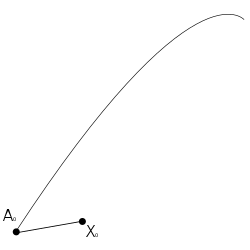Schild's ladder

In the theory of general relativity, and differential geometry more generally, Schild's ladder is a first-order method for approximating parallel transport of a vector along a curve using only affinely parametrized geodesics. The method is named for Alfred Schild, who introduced the method during lectures at Princeton University.
Construction
The idea is to identify a tangent vector x at a point with a geodesic segment of unit length , and to construct an approximate parallelogram with approximately parallel sides and as an approximation of the Levi-Civita parallelogramoid; the new segment thus corresponds to an approximately parallel translated tangent vector at
 A curve in M with a "vector" X0 at A0, identified here as a geodesic segment. |
 Select A1 on the original curve. The point P1 is the midpoint of the geodesic segment X0A1. |
 The point X1 is obtained by following the geodesic A0P1 for twice its parameter length. |
Formally, consider a curve γ through a point A0 in a Riemannian manifold M, and let x be a tangent vector at A0. Then x can be identified with a geodesic segment A0X0 via the exponential map. This geodesic σ satisfies
The steps of the Schild's ladder construction are:
- Let X0 = σ(1), so the geodesic segment has unit length.
- Now let A1 be a point on γ close to A0, and construct the geodesic X0A1.
- Let P1 be the midpoint of X0A1 in the sense that the segments X0P1 and P1A1 take an equal affine parameter to traverse.
- Construct the geodesic A0P1, and extend it to a point X1 so that the parameter length of A0X1 is double that of A0P1.
- Finally construct the geodesic A1X1. The tangent to this geodesic x1 is then the parallel transport of X0 to A1, at least to first order.
Approximation
This is a discrete approximation of the continuous process of parallel transport. If the ambient space is flat, this is exactly parallel transport, and the steps define parallelograms, which agree with the Levi-Civita parallelogramoid.
In a curved space, the error is given by holonomy around the triangle which is equal to the integral of the curvature over the interior of the triangle, by the Ambrose-Singer theorem; this is a form of Green's theorem (integral around a curve related to integral over interior).
Notes
- Schild's ladder requires not only geodesics but also relative distance along geodesics. Relative distance may be provided by affine parametrization of geodesics, from which the required midpoints may be determined.
- The parallel transport which is constructed by Schild's ladder is necessarily torsion-free.
- A Riemannian metric is not required to generate the geodesics. But if the geodesics are generated from a Riemannian metric, the parallel transport which is constructed in the limit by Schild's ladder is the same as the Levi-Civita connection because this connection is defined to be torsion-free.
References
- Kheyfets, Arkady; Miller, Warner A.; Newton, Gregory A. (2000), "Schild's ladder parallel transport procedure for an arbitrary connection", International Journal of Theoretical Physics, 39 (12): 2891–2898.
- Misner, Charles W.; Thorne, Kip S.; Wheeler, John A. (1973), Gravitation, W. H. Freeman, ISBN 0-7167-0344-0